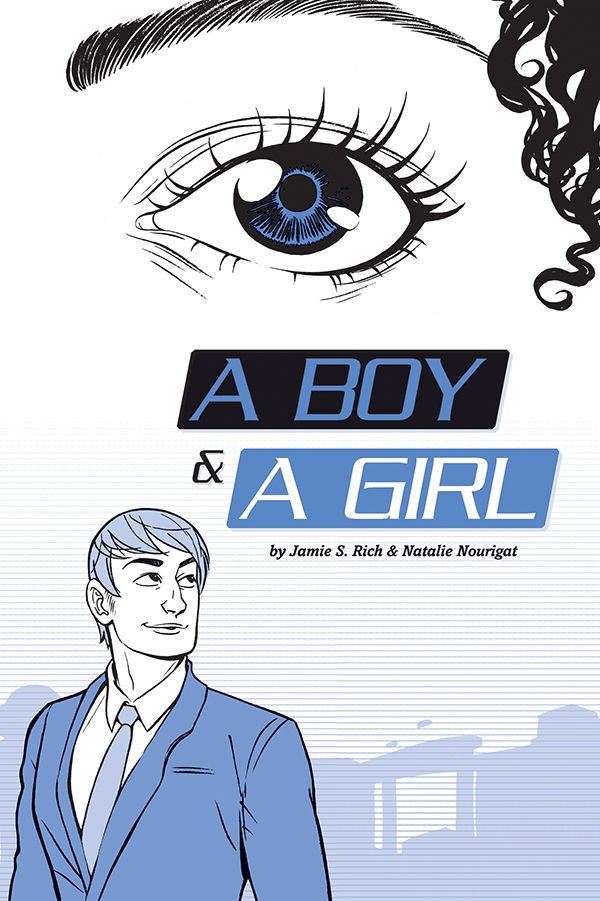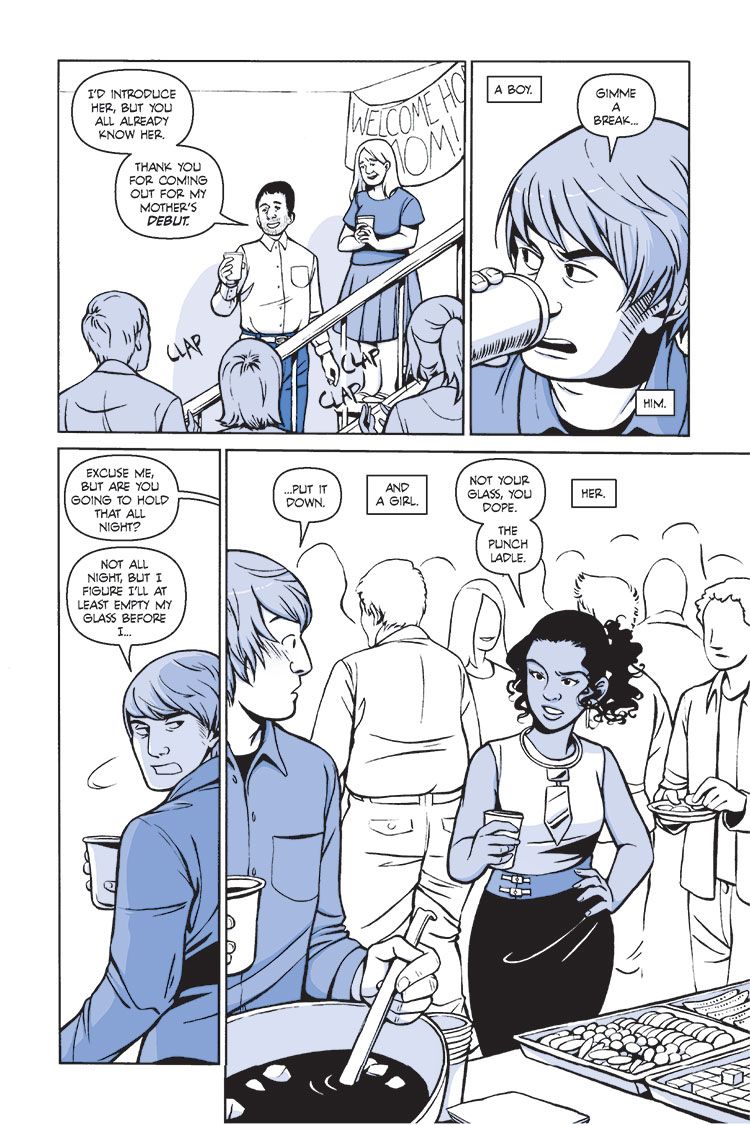Dec. 11 will see the release of the latest collaboration between artist Natalie Nourigat and writer Jamie S. Rich, A Boy & a Girl, a 160-page sci-fi romance. Published by Oni Press (Diamond Order Code: JUL131213), the graphic novel is a futuristic story that considers an Earth where life-like androids are becoming just as common as real humans, and where a guy named Travis decides he just has to get a date with a girl named Charley. That spark of interest leads to a whole slew of quirky turns and revelations. I recently caught up with Nourigat, who's normally based out of Portland, Oregon's Periscope Studio but is spending a year in France, to discuss her latest work. To get a slice of the story, be sure to check out Oni's 10-page preview.
Tim O'Shea: Was there any specific element in particular about Jamie S. Rich's script that persuaded you to want to draw the story?
Natalie Nourigat: I wanted to draw the story before I even knew what the story was, because I wanted to work with Jamie again. He was really open to collaboration, and from the beginning he invited me to suggest elements that interested me to steer us into something that would be fun for both of us. I wanted a time-travel story, and then a futuristic sci-fi setting, and then the split-perspective angle as things progressed.
How much back and forth was there between you and Jamie in terms of trying to design Charley and Travis?
A lot. He really set me loose on the designs with no restrictions about physical attributes -- only their character bios and the first version of the script. I was allowed to draw Travis and Charley dozens of different ways and experiment a lot in the first passes. They were all over the place, and really fun for me. Jamie offered feedback when I wanted it, and I wanted it often, because I really wanted the characters to fit how he envisioned them. He guided me toward designs that meshed with what our characters needed to say and do.
How much does working in Periscope Studio help to nurture your work?
So much. I’m in France at the moment (taking a belated year abroad), and I am very homesick for my studio. Periscope is where I learned that drawing comics even was a career option, let alone how to use Photoshop or lay down a perspective grid or letter in Manga Studio or form the perfect tip on your brush or talk to publishers or be professional on Twitter. … Periscope is truly a hub of positive creative energy. It’s chicken soup for the comics creator’s soul. There’s nothing like sharing a workspace with people who get what you do, support you, and have diverse experiences and knowledge to share with you. I’m not the first to say this, but Periscope quickly becomes more of a second home/family than an office.
Can you talk about why the book is colored in hues of blue (as opposed to opting for black and white) or say hues of green or another color?
Yes, [Art Director] Keith Wood at Oni Press generously gave me quite a bit of his time just to talk about the look for the book before I began drawing. Petrograd was fresh off the press when I started A Boy & a Girl, and the Pantones in that book are really lovely and effective. Keith liked Pantone for A Boy & a Girl, and since he was able to show me how to work in Pantone in Photoshop fairly quickly, I decided to pick up a new skill and try it. I love working with black and white line art plus digital grayscale tones, and working with the Pantone turned out to not be too different from that. The royal blue adds a little depth, another dimension, another element to consider. It can be saturated or gray, vibrant or subtle. The fact that it’s a bold color can make things pop out from the line art. We liked a cold blue for the sci-fi side of the book, but ultimately wanted to make it a little warmer to work for the intimate/romantic scenes. We had considered an orange/yellow that could similarly work for cold and warm moments, but it ended up looking to much like sepia tone and contradicting the futuristic images. I really like what we landed on.
When you tackle a story set in the future, how do you decide upon the kind of cityscapes you want to have--or make the decision to have flying cars or other advanced technology?
Whenever we went out on a limb with a futuristic design, like for the flying cars, mekshaws, and (spoiler) suicide catchers, it was there for a story reason. For the most part the world is not so far removed from out own, as we’re only 25 years down the line.
Romance is challenging to convey normally, how much more challenging was it when to execute when artificial intelligence is thrown into the mix?
Not so bad! (Spoilers) Our androids are so life-like; I was drawing them and thinking of them as people. I think it was more on Jamie’s end, forming the script and the flirtatious dialogue while debating the morality and implications of artificial intelligence, that must have been tricky.
I was struck by a recent tweet of yours: "Doodling Charley and Emily from A Boy & a Girl: I miss drawing them." Is it more of a good or a bittersweet moment (or something else all together) when you clearly connect with characters in a project like this?
Oh, it’s great. They exist now and I can always go back and draw them again if I miss them. I’m really happy to have worked on a project with characters I resonated with and enjoyed drawing like this.
There's so much to love about your art -- your characters' facial reactions, your utilization of body language -- but oddly enough I am often struck at the way you convey characters' clothes. I cannot put my finger on why the way clothes hang on your characters works so effectively for me. Is that something that comes naturally to you when you draw, or is that a quality you've worked hard to achieve?
Well, thank you! I love drawing clothes. I have a coping mechanism when there’s something beautiful I want and can’t have, and it’s drawing one of my characters wearing it. So, often, my female characters are wearing things I’ve longed for and thought long and hard about! And I love going to cafes and drawing people I see on the street, which has been a huge help in terms of learning how clothing hangs on the body and can amplify gestures and personality.
At one point, some pivotal scenes for the story takes readers to an abandoned church. Setting the scenes there, were you and Rich trying to make a statement--or could the scenes have taken place in any type of abandoned building?
While Jamie was writing the first version of the script, he came to me with a couple of chapters where there was still room for input, and asked me if there was anything I particularly wanted to draw or any questions about the world I wanted him to answer with that space. I think I told him I wanted to draw the characters scaling something, like a bridge or abandoned building or a church, and asked if there were even churches in a big futuristic city. He ran with it and created this great scene that explains where religion finds itself in a world with replicated intelligence.
What do you want to talk about before we call this interview a wrap?
I am so very, very happy to see this book come out. It was a labor of love and an incredibly rewarding project. Look for my and Jamie’s work in the future, and hopefully another collaboration somewhere down the line!



